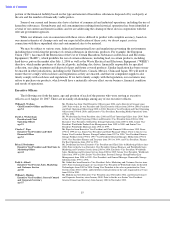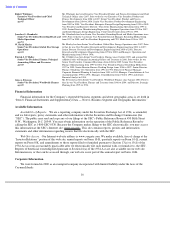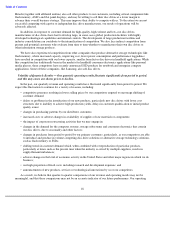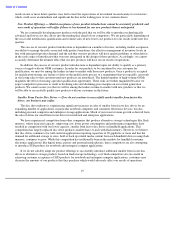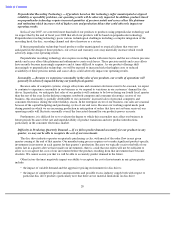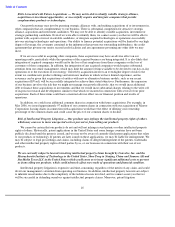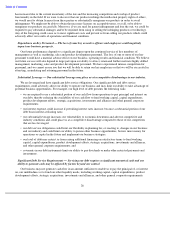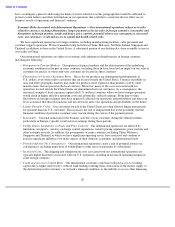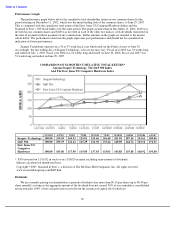Seagate 2006 Annual Report Download - page 25
Download and view the complete annual report
Please find page 25 of the 2006 Seagate annual report below. You can navigate through the pages in the report by either clicking on the pages listed below, or by using the keyword search tool below to find specific information within the annual report.
Table of Contents
these components, including recording media and aluminum and glass substrates that we do not manufacture, ASICs,
spindle motors, printed circuit boards and suspension assemblies. Recently, substantially all of our purchases of
recording media and a significant portion of our aluminum substrates from third-party suppliers have been sourced
from Komag, which is in the process of being acquired by Western Digital. There can be no assurance that we will
continue to be able to obtain alternative supply following the purchase of Komag by Western Digital.
In the past, we have experienced increased costs and production delays when we were unable to obtain the
necessary equipment or sufficient quantities of some components and/or have been forced to pay higher prices or
make volume purchase commitments or advance deposits for some components, equipment or raw materials, such as
precious metals like platinum and ruthenium, that were in short supply in the industry in general.
Historically, the technology sector specifically, and the economy generally have experienced economic pressure,
which has resulted in consolidation among component manufacturers and may result in some component
manufacturers exiting the industry or not making sufficient investments in research to develop new components.
If there is a shortage of, or delay in supplying us with, critical components, equipment or raw materials, then:
We cannot assure you that we will be able to obtain critical components in a timely and economic manner, or at
all.
Importance of Reducing Operating Costs — If we do not reduce our operating expenses, we will not be able to
compete effectively in our industry.
Our strategy involves, to a substantial degree, increasing revenue and product volume while at the same time
reducing operating expenses. In the past, these activities have included closures and transfers of facilities, significant
personnel reductions and efforts to increase automation. Moreover, the reduction of personnel and closure of
facilities may adversely affect our ability to manufacture our products in required volumes to meet customer demand
and may result in other disruptions that affect our products and customer service. In addition, the transfer of
manufacturing capacity of a product to a different facility frequently requires qualification of the new facility by
some of our OEM customers. We cannot assure you that these activities and transfers will be implemented on a cost-
effective basis without delays or disruption in our production and without adversely affecting our customer
relationships and results of operations.
Industry Demand — Changes in demand for computer systems and storage subsystems has caused and may
cause in the future a decline in demand for our products.
Our disc drives are components in computers, computer systems, storage subsystems and consumer electronics
devices. The demand for these products has been volatile. In a weak economy, consumer spending tends to decline
and retail demand for personal computers and consumer electronics devices tends to decrease, as does enterprise
demand for computer systems and storage subsystems. Unexpected slowdowns in demand for computer systems and
storage subsystems generally cause sharp declines in demand for disc drive products.
22
• it is likely that our suppliers would raise their prices and, if we could not pass these price increases to our
customers, our operating margin would decline;
• we might have to reengineer some products, which would likely cause production and shipment delays, make
the reengineered products more costly and provide us with a lower rate of return on these products;
• we would likely have to allocate the components we receive to certain of our products and ship less of others,
which could reduce our revenues and could cause us to lose sales to customers who could purchase more of
their required products from manufacturers that either did not experience these shortages or delays or that
made different allocations; and
• we might be late in shipping products, causing potential customers to make purchases from our competitors,
thus causing our revenue and operating margin to decline.





